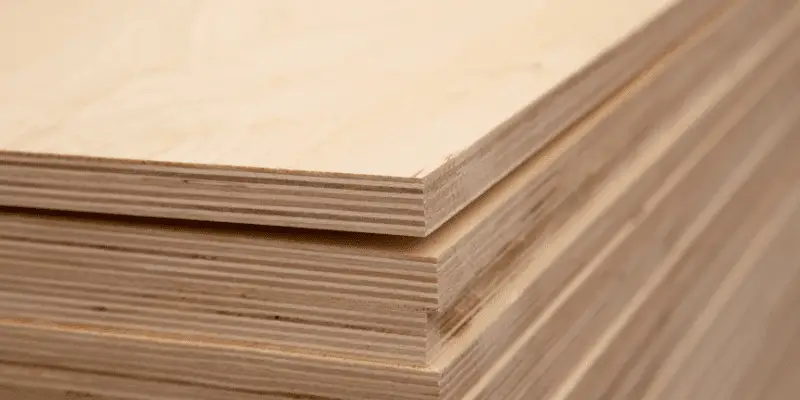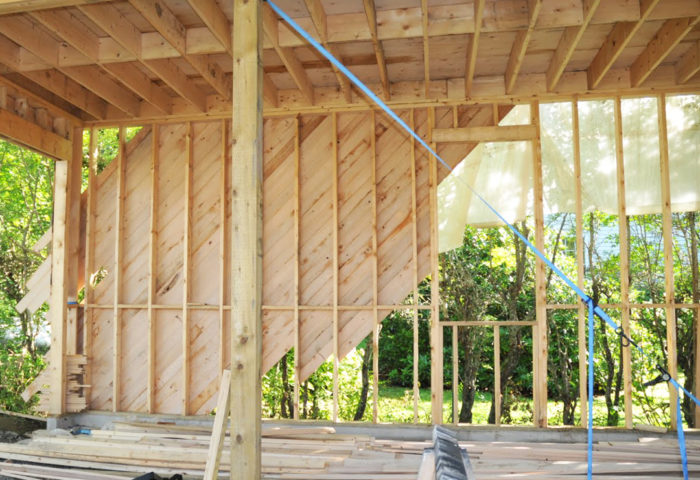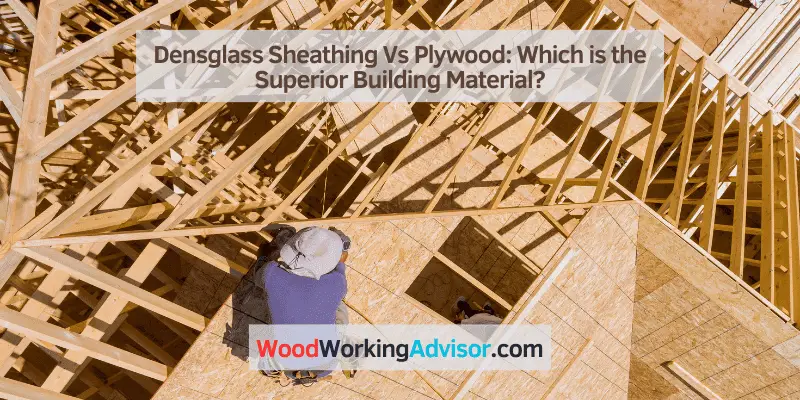Densglass sheathing offers superior moisture resistance and better fire and mold resistance than plywood. It is a great alternative for exterior sheathing where moisture and fire protection are important.
In addition, Densglass sheathing provides a flat and durable surface for cladding and offers enhanced dimensional stability compared to plywood. It is also easier to install and requires less maintenance, making it an ideal choice for construction projects. With its superior performance and durability, Densglass sheathing proves to be a more reliable and long-lasting option when compared to plywood.
Understanding The Key Differences
When it comes to choosing the right sheathing material for your construction project, two popular options that often come up are Densglass sheathing and plywood. While both materials serve the same purpose of providing structural support, they possess distinct characteristics that set them apart. Understanding these key differences is crucial to making an informed decision. Let’s take a closer look at the characteristics, composition, durability, strength, and fire resistance of Densglass sheathing and plywood.
Characteristics Of Densglass Sheathing And Plywood
Densglass sheathing, as its name suggests, is a fiberglass mat gypsum sheathing that consists of a non-combustible core. It is designed to provide a smooth and durable surface for exterior cladding systems. On the other hand, plywood is made from multiple layers of thin wood veneers that are glued together, resulting in a strong and versatile sheet material.
Composition And Manufacturing Process
The composition of Densglass sheathing includes a gypsum core faced with fiberglass mats on both sides. These mats are saturated with a water-resistant formulation, which gives it excellent protection against moisture. In contrast, plywood is made from layers of wood veneers, usually from softwood species like pine or fir, that are stacked and bonded together with adhesive. This manufacturing process gives plywood its strength and dimensional stability.
Durability And Resistance To Moisture
When it comes to durability and resistance to moisture, Densglass sheathing has a clear advantage. Its gypsum core and water-resistant formulation make it highly resistant to mold, mildew, and rot. Additionally, it can withstand exposure to extreme weather conditions and has a high mold resistance index (MRI) rating. Plywood, while also having some resistance to moisture, is more susceptible to damage from prolonged exposure to water and may require additional treatments or protective coatings.
Strength And Load-bearing Capacity
Both Densglass sheathing and plywood offer good strength and load-bearing capacity, but plywood has the edge in terms of overall strength. Plywood’s layered construction provides it with enhanced structural integrity, making it ideal for applications where maximum strength is required. Densglass sheathing, however, is still a reliable option for most residential and light commercial projects.
Fire Resistance And Safety Features
Fire resistance is a crucial consideration in any construction project, and both Densglass sheathing and plywood offer fire-resistant properties. Densglass sheathing comes with a fire-resistance rating of up to 1-2 hours, making it an excellent choice for fire-rated assemblies. Plywood, while combustible, can also provide fire resistance when properly treated with fire-retardant chemicals or used in combination with other fire-rated materials.
In conclusion, the choice between Densglass sheathing and plywood ultimately depends on your specific project requirements and budget. Densglass sheathing offers superior moisture resistance and fire resistance, making it an excellent choice for areas prone to high humidity or fire hazards. On the other hand, plywood provides strength, versatility, and cost-effectiveness. Analyzing the characteristics, composition, durability, strength, and fire resistance of both materials is vital in selecting the right sheathing solution for your construction needs.
Comparing Installation Process
Comparing the installation processes of Densglass Sheathing and plywood reveals key differences. While Densglass Sheathing offers ease of installation with its lightweight and durable nature, plywood requires more effort due to its heavier weight and need for careful handling.
When it comes to choosing the right sheathing for your construction projects, two popular options are Densglass and plywood. Each has its own advantages and disadvantages, so it’s important to weigh them against each other. In this section, we will focus on the installation process and compare the ease of installation, the tools and equipment required, the step-by-step process, and potential challenges along the way.
Ease Of Installation
Both Densglass sheathing and plywood have their unique qualities when it comes to installation. Let’s take a closer look at each:
For Densglass sheathing, the installation is relatively straightforward. The panels are lightweight and easy to handle, making it easier to maneuver and install. This can save time and effort during the construction process. With its tongue-and-groove design, the panels fit together easily, resulting in a tight and secure installation.
On the other hand, plywood installation requires a bit more effort. The panels are heavier and may require more manpower during installation. However, plywood offers more flexibility in terms of cutting and shaping to fit different project requirements. With proper tools and techniques, plywood can be installed efficiently.
Tools And Equipment Required
Step-by-step Installation Process
Densglass Sheathing Installation Process:
- Prepare the wall by ensuring it is clean and free of debris.
- Measure and cut the Densglass panels to fit the wall.
- Apply a layer of adhesive to the wall studs.
- Attach the Densglass panels to the wall by nailing or screwing them into place.
- Seal the seams between the panels using Densglass-approved tape or joint compound.
- Finish the installation by applying a weather-resistant barrier, such as house wrap or building paper, over the Densglass panels.
Plywood Installation Process:
- Prepare the wall by ensuring it is clean and free of debris.
- Measure and cut the plywood panels to fit the wall.
- Nail or screw the plywood panels to the wall studs, ensuring they are securely fastened.
- Seal the seams between the panels using plywood-approved tape or joint compound.
- Finish the installation by applying a weather-resistant barrier, such as house wrap or building paper, over the plywood panels.
Potential Challenges And How To Overcome Them
During the installation process, there may be some challenges that arise. Here are a few common ones and how to overcome them:
1. Moisture management: Both Densglass sheathing and plywood are susceptible to moisture damage if not properly protected. To overcome this challenge, ensure proper flashing and sealing around windows, doors, and other openings. Additionally, consider using a moisture barrier or waterproofing membrane to further protect the sheathing.
2. Inadequate fastening: When installing either Densglass sheathing or plywood, it’s crucial to use the recommended nails or screws and follow the manufacturer’s guidelines for spacing and fastening. Inadequate fastening can lead to loose panels and compromised structural integrity.
3. Alignment and leveling: Achieving a level and aligned installation can be challenging, particularly with larger panels. To overcome this, take the time to properly measure and mark the wall studs, ensuring accurate placement of the sheathing or plywood. Use a level and straightedge to guide the installation.
4. Special considerations for fire-rated assemblies: If you are working on a project that requires fire-rated assemblies, specific installation requirements must be followed. Ensure compliance with local building codes and consult with the manufacturer for detailed instructions on installation in fire-rated assemblies.
In conclusion, both Densglass sheathing and plywood have their own advantages and disadvantages when it comes to the installation process. Consider the ease of installation, required tools and equipment, step-by-step process, and potential challenges before making a decision. Proper installation is crucial for a long-lasting and structurally sound project.

Analyzing Cost And Efficiency
When it comes to choosing the right sheathing material for your construction projects, it’s essential to consider both cost and efficiency. Two popular options that often come up in this discussion are Densglass sheathing and plywood. In this section, we will delve deeper into the cost comparison and efficiency of these two materials, helping you make an informed decision for your next project.
Cost Comparison Of Densglass Sheathing And Plywood
One of the primary factors to consider when evaluating construction materials is their initial material cost. While Densglass sheathing may have a slightly higher upfront cost compared to plywood, it offers a range of benefits that make it a cost-effective choice in the long run.
Initial Material Cost
Although Densglass sheathing may have a higher initial material cost than plywood, its unique composition makes it highly durable and resistant to moisture, reducing the need for frequent replacements or repairs. Its reinforced fiberglass mat provides superior protection against mold, rot, and warping, ensuring the longevity of your building’s structure and saving you money on maintenance and replacement expenses.
Long-term Maintenance And Replacement Expenses
When calculating the overall cost of your project, it’s crucial to consider the long-term maintenance and replacement expenses associated with the chosen sheathing material. Plywood, while initially cheaper, may require more frequent maintenance and replacement due to its susceptibility to moisture damage. On the other hand, Densglass sheathing’s moisture resistance lowers the risk of costly repairs and replacements over time, providing significant savings in the long run.
Energy Efficiency And Insulation
Besides cost, energy efficiency is an essential aspect to consider when evaluating construction materials. Densglass sheathing excels in this area, offering excellent insulation properties that can significantly improve a building’s energy efficiency. The enhanced thermal resistance provided by Densglass sheathing reduces heat loss during colder months and minimizes heat gain during warmer months, resulting in reduced energy consumption and lower utility bills.
Thermal Performance And Energy Savings
Densglass sheathing’s superior thermal performance not only contributes to energy savings but also enhances overall comfort within the building. By reducing drafts and temperature fluctuations, this sheathing material creates a more consistent and comfortable indoor environment, promoting productivity and well-being among the occupants. Additionally, the improved energy efficiency can potentially qualify your building for energy-saving incentives or certifications, further reducing operational costs.
Impact On Hvac Systems And Utility Bills
Another factor to consider when evaluating sheathing materials is their impact on HVAC systems and utility bills. Densglass sheathing’s ability to reduce heat transfer can significantly lighten the burden on HVAC systems, allowing them to operate more efficiently and potentially extending their lifespan. This translates to lower maintenance and replacement costs for your HVAC system, contributing further to the overall cost savings of using Densglass sheathing.

Credit: www.greenbuildingadvisor.com
Evaluating Performance In Various Environmental Conditions
Evaluating performance in various environmental conditions reveals that Densglass Sheathing outperforms plywood. Its exceptional moisture resistance and durability make it a superior choice for protecting buildings from water damage and ensuring long-lasting structural stability.
Moisture Resistance And Mold Prevention
When comparing Densglass sheathing and plywood, one crucial factor to consider is their performance in various environmental conditions. Moisture resistance and mold prevention are of utmost importance in maintaining the integrity of the structure. Densglass sheathing, an innovative building material, has distinct advantages in this aspect.
Densglass sheathing possesses exceptional moisture resistance due to its unique composition and manufacturing process. Unlike plywood, Densglass sheathing is engineered with a fiberglass mat facing, offering a highly durable and water-resistant barrier. This feature ensures that moisture does not seep into the sheathing, effectively protecting the underlying structure from potential damage.
Moreover, Densglass sheathing also excels in mold prevention. Its non-porous surface minimizes the potential for mold growth, even in high-moisture environments. This quality is particularly significant for applications where moisture control is a top priority, such as in regions with humid climates or areas prone to frequent rainfall. As a result, structures utilizing Densglass sheathing are less susceptible to the detrimental effects of mold, promoting a healthy indoor environment.
Impact Resistance And Structural Stability
In addition to moisture resistance, evaluating the impact resistance and structural stability of Densglass sheathing and plywood is crucial for ensuring long-term durability. Densglass sheathing emerges as the winning choice in this area as well.
Densglass sheathing offers exceptional impact resistance due to its fiberglass mat facing and engineered gypsum core. This construction provides a sturdy and rigid foundation that can withstand various impact forces, such as those caused by hail, debris, or accidental collisions. In contrast, plywood may be more susceptible to dents, punctures, or cracks, potentially compromising the structural integrity of the building.
Structural stability is another notable advantage of Densglass sheathing. The consistent composition throughout the entire panel ensures uniform strength, minimizing the risk of weak spots or vulnerabilities. This quality translates to a safer and more reliable solution for building projects of any scale, providing peace of mind to builders and homeowners alike.
Performance In Extreme Weather Conditions
When evaluating building materials, it is essential to consider their performance in extreme weather conditions. Densglass sheathing demonstrates exceptional resilience in the face of harsh elements, making it an ideal choice for regions with extreme weather patterns.
Densglass sheathing offers remarkable performance in extreme heat and cold, maintaining its structural integrity without warping or deteriorating. The engineered gypsum core provides inherent fire resistance, ensuring the safety of the structure even in the event of a fire. This quality is particularly advantageous in fire-prone areas, where the ability to limit the spread of flames can be crucial.
Additionally, Densglass sheathing performs admirably in high-wind conditions, thanks to its robust composition. The fiberglass mat facing and engineered core contribute to superior wind resistance, reducing the risk of sheathing detachment and potential damage to the structure during storms or hurricanes. This resilience, coupled with its moisture resistance and impact resistance, makes Densglass sheathing an excellent choice for buildings in areas prone to severe weather.
Thermal Expansion And Contraction
Ensuring a building material can withstand thermal expansion and contraction is essential for maintaining its structural stability over time. Densglass sheathing offers excellent thermal stability, making it a reliable choice in this regard.
By utilizing the right installation techniques, Densglass sheathing minimizes the risk of buckling, warping, or other structural distortions caused by temperature fluctuations. Its engineered gypsum core and fiberglass mat facing are designed to limit the impact of thermal expansion and contraction, ensuring the sheathing remains secure and intact, regardless of the temperature changes it encounters.
In conclusion, when evaluating performance in various environmental conditions, Densglass sheathing emerges as a superior choice when compared to plywood. Its moisture resistance and mold prevention capabilities, impact resistance and structural stability, performance in extreme weather conditions, wind resistance, and thermal stability make it an exceptional building material for a wide range of applications. Whether constructing a residential home or a commercial building, Densglass sheathing delivers on multiple fronts, providing builders and homeowners with a reliable, durable, and long-lasting solution.
Exploring Applications And Building Code Compliance
When it comes to choosing the right sheathing for your construction project, it is crucial to consider not only the suitability of the material for various applications but also its compliance with building codes. In this section, we will delve into the applications of Densglass sheathing and plywood, while also exploring their respective limitations and compliance with building code requirements.
Suitable Applications For Densglass Sheathing
Densglass sheathing is a versatile material that finds its extensive use in both commercial and residential construction. Let’s take a closer look at the suitability of this sheathing for different applications:
Commercial Buildings
In commercial construction, Densglass sheathing proves to be an excellent choice due to its durability, fire resistance, and moisture resistance properties. Whether it’s an office building, a retail space, or a multi-story complex, Densglass sheathing provides a reliable structural barrier.
Residential Construction
When it comes to residential construction, Densglass sheathing offers notable advantages. It enhances the stability of the structure, acts as an outstanding air barrier, and offers moisture resistance, all of which contribute to the longevity and comfort of a home.
Plywood Applications And Limitations
Plywood is a traditional and widely used sheathing material that also has its unique set of applications and limitations. Let’s explore them:
Considerations for Different Types of Construction
In a variety of construction projects, plywood proves to be a reliable choice. From framing to subflooring, plywood is widely used due to its strength and versatility. However, it does have some limitations. For instance, in areas with high humidity or potential water exposure, plywood may be prone to moisture damage, limiting its usage in damp environments.
Building Code Requirements and Compliance for Both Materials
Both Densglass sheathing and plywood must adhere to specific building code requirements to ensure compliance and safety. These requirements vary depending on the location and specific project. For instance, International Building Code (IBC) standards outline the minimum sheathing thickness, fire resistance ratings, and wind load capacities to be met.
It’s essential to consult with local building authorities and professionals to ensure compliance with the applicable building codes for your project and to choose the sheathing material that best meets these requirements.
Frequently Asked Questions Of Densglass Sheathing Vs Plywood
Can Densglass Be Used As Structural Sheathing?
Yes, DensGlass can be used as structural sheathing. It provides excellent resistance to fire, moisture, and mold. DensGlass is a high-quality option for enhancing the structural stability of buildings and ensuring a durable and safe construction process.
What Is Densglass Sheathing Used For?
DensGlass Sheathing is used as an exterior sheathing for walls in commercial and residential construction. It provides a durable and moisture-resistant barrier that helps protect buildings from damage and increases their energy efficiency.
Can You Use Densglass For Exterior Walls?
Yes, DensGlass can be used for exterior walls.
How Strong Is Densglass?
DensGlass is an exceptionally sturdy material with unmatched strength. It provides structural integrity and resists moisture, mold, and fire. With its robust composition, DensGlass assures durability and long-lasting performance in various applications.
Conclusion
Ultimately, choosing between Densglass sheathing and plywood comes down to your specific needs and priorities. Both options have their advantages and disadvantages, so it’s important to carefully consider factors such as cost, durability, and ease of installation. Whether you prioritize moisture resistance, fire resistance, or overall strength, understanding the unique characteristics of each option will help you make an informed decision for your project.
So, delve into your requirements and make the choice that best aligns with your goals.


